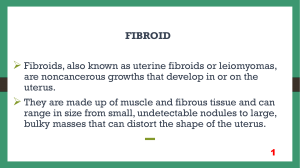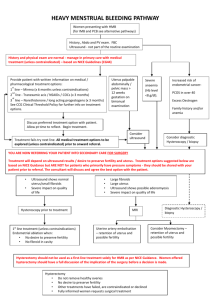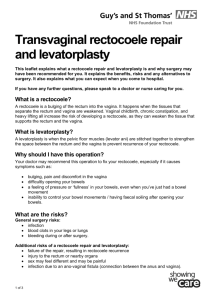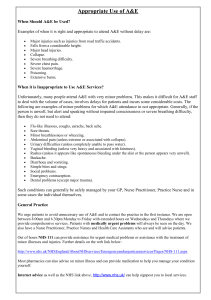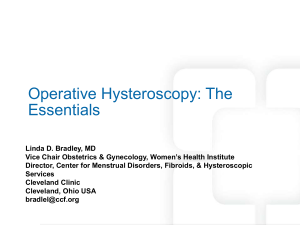Polyps or fibroids removal surgery
advertisement
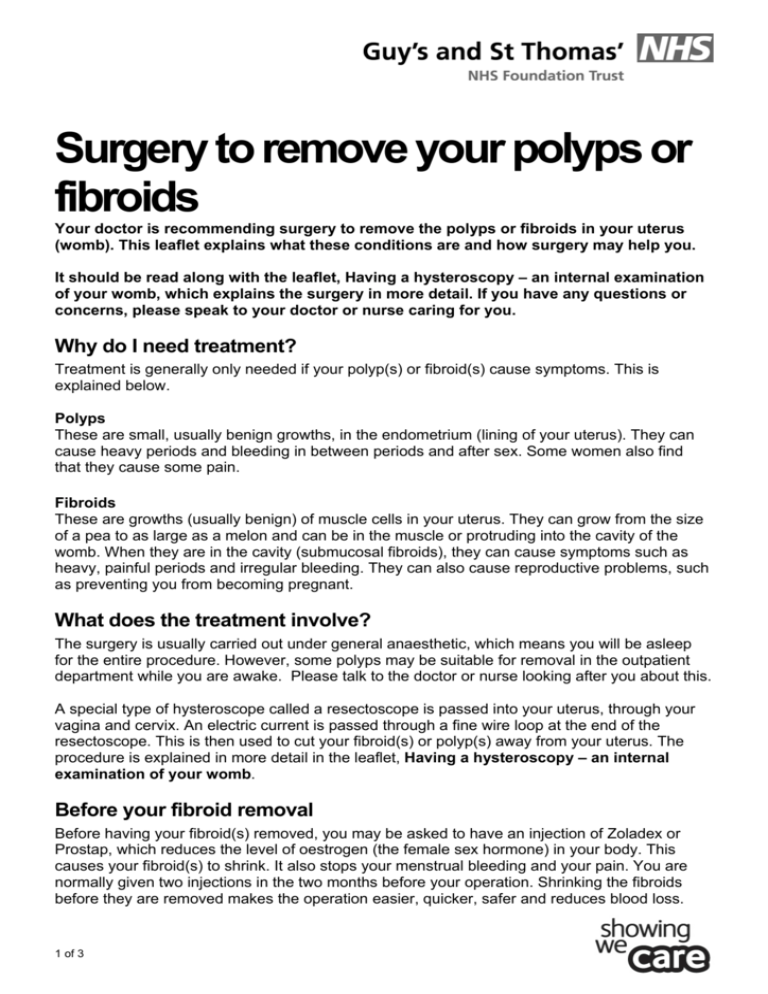
Surgery to remove your polyps or fibroids Your doctor is recommending surgery to remove the polyps or fibroids in your uterus (womb). This leaflet explains what these conditions are and how surgery may help you. It should be read along with the leaflet, Having a hysteroscopy – an internal examination of your womb, which explains the surgery in more detail. If you have any questions or concerns, please speak to your doctor or nurse caring for you. Why do I need treatment? Treatment is generally only needed if your polyp(s) or fibroid(s) cause symptoms. This is explained below. Polyps These are small, usually benign growths, in the endometrium (lining of your uterus). They can cause heavy periods and bleeding in between periods and after sex. Some women also find that they cause some pain. Fibroids These are growths (usually benign) of muscle cells in your uterus. They can grow from the size of a pea to as large as a melon and can be in the muscle or protruding into the cavity of the womb. When they are in the cavity (submucosal fibroids), they can cause symptoms such as heavy, painful periods and irregular bleeding. They can also cause reproductive problems, such as preventing you from becoming pregnant. What does the treatment involve? The surgery is usually carried out under general anaesthetic, which means you will be asleep for the entire procedure. However, some polyps may be suitable for removal in the outpatient department while you are awake. Please talk to the doctor or nurse looking after you about this. A special type of hysteroscope called a resectoscope is passed into your uterus, through your vagina and cervix. An electric current is passed through a fine wire loop at the end of the resectoscope. This is then used to cut your fibroid(s) or polyp(s) away from your uterus. The procedure is explained in more detail in the leaflet, Having a hysteroscopy – an internal examination of your womb. Before your fibroid removal Before having your fibroid(s) removed, you may be asked to have an injection of Zoladex or Prostap, which reduces the level of oestrogen (the female sex hormone) in your body. This causes your fibroid(s) to shrink. It also stops your menstrual bleeding and your pain. You are normally given two injections in the two months before your operation. Shrinking the fibroids before they are removed makes the operation easier, quicker, safer and reduces blood loss. 1 of 3 One of the possible side effects of the injections is menopause-like symptoms, such as hot flushes, dry vagina and night sweats. These symptoms stop soon after the last injection. However, if these side effects cause severe problems, you should contact either us or your GP as we can give you hormone replacement tablets (Tibalone) to counteract them. Are there any other treatment options? Your doctor/nurse will discuss your treatment options with you in more detail. These will depend on the size of your fibroids or polyps and the severity of your symptoms. Will my fibroids/polyps return? Removing your polyp(s) will, in most cases, improve your symptoms after your operation. However, some women are more prone to polyps and may find that they return. It can take several months, before you notice a significant improvement in your symptoms. They grow back in about 30% of women who have them removed. Also, about 30% of women experience heavy bleeding again within three years of their fibroids being removed. Your doctor or nurse will discuss this with you in more detail before the operation. After the operation It should take about two to seven days to recover at home from the operation. This is mainly to recover from the effects of the anaesthetic, although you will have some bleeding and some period pain afterwards. This bleeding can last up to two weeks, and you can have vaginal discharge for up to four weeks. What are the risks? The general risks are outlined in the hysteroscopy leaflet. Your doctor or nurse will discuss these with you in more detail, along with the following potential complications of removing fibroids or polyps: • Your fibroid is too large to be removed in one operation, in which case the procedure may need to be repeated. • The fluid called glycine, which your doctor uses to help see inside your uterus, is absorbed by your body. This is monitored during your operation and if too much is absorbed, the operation will be stopped, sometimes before the operation is complete. You may have to stay in hospital overnight for monitoring. What shall I do if I have a problem or concern after the procedure? Please: • contact or visit your GP • call the gynaecology ward for advice on 0207 188 2703/0207 188 2697 • call NHS Direct and speak to a specially trained nurse on 0845 4647 • in the event of an emergency go to your nearest A&E or call 999. 2 of 3 Contact us If you have any questions or concerns about having a hysteroscopy, please contact either: • 020 7188 3222 – Monday to Friday, 9am to 5pm if you are having the hysteroscopy in the day surgery unit or • 020 7188 3023 – Monday to Friday 9am to 5pm (answer phone except Wednesday 2pm– 4pm) to speak with a specialist nurse about having the hysteroscopy in the outpatient department. Further sources of information Pharmacy medicines helpline For information about any medicines that you have been prescribed at Guy's and St Thomas' hospitals, you can speak to the staff caring for you or call our helpline. t: 020 7188 8748 9am to 5pm, Monday to Friday. Patient Advice and Liaison Service (PALS) – To make comments or raise concerns about the Trust’s services, please contact PALS. Ask a member of staff to direct you to the PALS office or: t: 020 7188 8801 at St Thomas’ t: 020 7188 8803 at Guy’s e: pals@gstt.nhs.uk Knowledge & Information Centre (KIC) – For more information about health conditions, support groups and local services, or to search the internet and send emails, please visit the KIC on the Ground Floor, North Wing, St Thomas’ Hospital. t: 020 7188 3416 Language support services – If you need an interpreter or information about your care in a different language or format, please get in touch using the following contact details. t: 020 7188 8815 fax: 020 7188 5953 NHS Direct – Offers health information and advice from specially trained nurses over the phone 24 hours a day. t: 0845 4647 w: www.nhsdirect.nhs.uk NHS Choices – Provides online information and guidance on all aspects of health and healthcare, to help you make choices about your health. w: www.nhs.uk Become a member of your local hospitals, and help shape our future Membership is free and it is completely up to you how much you get involved. To become a member of our Foundation Trust, you need to be 18 years of age or over, live in Lambeth, Southwark, Lewisham, Wandsworth or Westminster or have been a patient at either hospital in the last five years. To join, please call 0848 143 4017, email members@gstt.nhs.uk or visit www.guysandstthomas.nhs.uk Leaflet number: 1712 / VER2 3 of 3 Date published: January 2013 Review date: January 2016 © 2012 Guy’s and St Thomas’ NHS Foundation Trust
